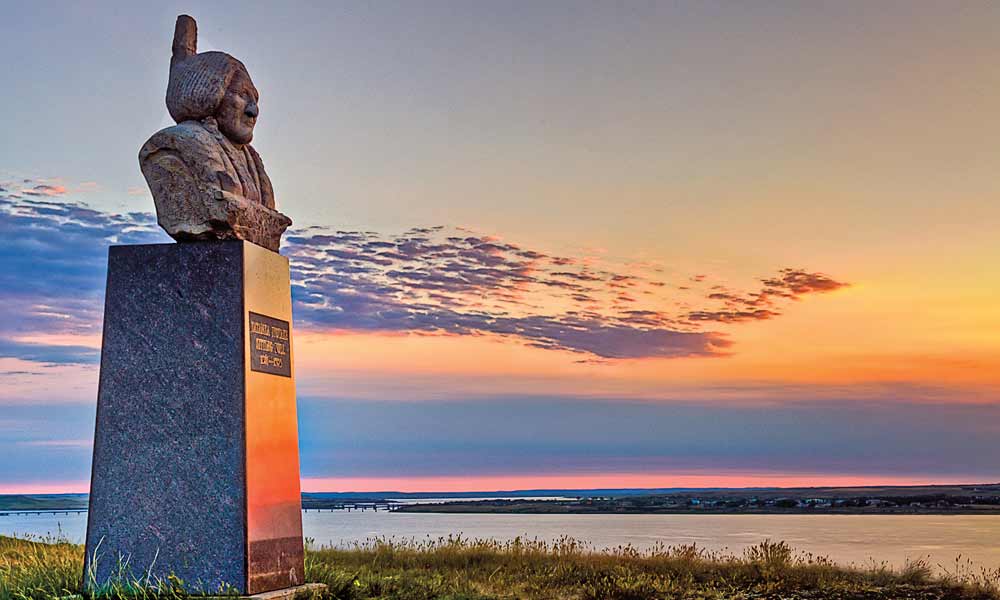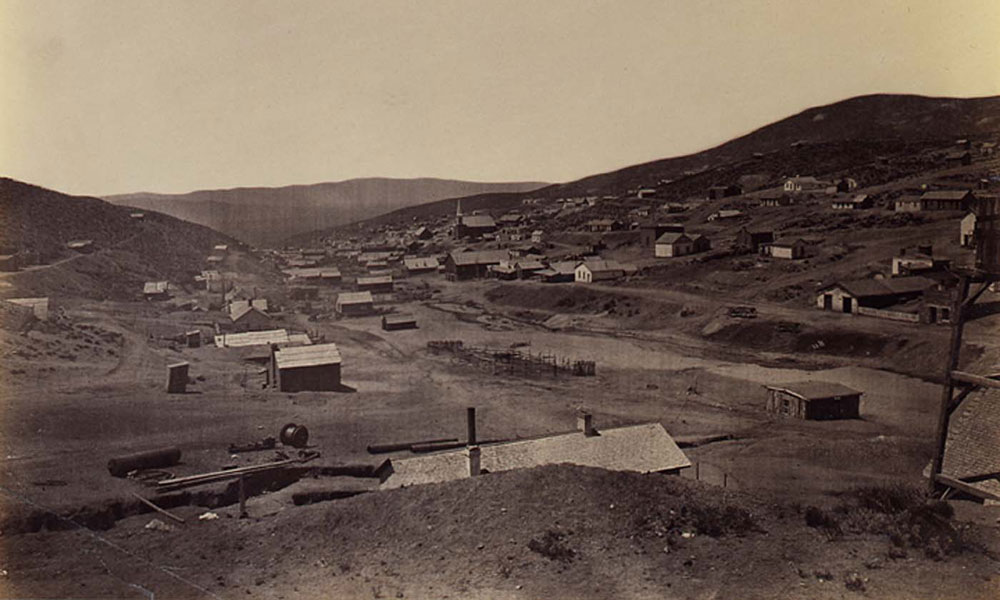
– True West Archives –
Sitting Bull strived to retain Lakota lifestyle and lands. He belonged to the Hunkpapa tribe of the Lakota people, also known as the Sioux. His name, Tatanka Iyotake, Sitting Bull, more fully means a stubborn male bison that will sit on his haunches and fight to the death. The Hunkpapas consider Sitting Bull a Wichasha Wakan, a person who experiences spiritual visions.
Sitting Bull was a leader of the Strong Hearts warrior society and a leader of the Silent Eaters, who looked after the Hunkpapa people. He fought against traditional enemies and new emerging enemies—American pioneers and soldiers. In 1857, the Hunkpapas selected Sitting Bull as war chief, and in 1868, the Lakota leadership meeting to discuss white encroachment, decided to concentrate power in one man who held all four Lakota virtues—bravery, fortitude, generosity and wisdom— and also selected Sitting Bull for the new position of war chief of the Lakotas.
In June 1876, three armies converged on the Lakota people and other tribes in their hunting grounds along the Big Horn Mountains. A large village gathered on Rosebud Creek. Sitting Bull held a sun dance, cutting and sacrificing 200 pieces of flesh from his arms, requesting Wakan Tanka’s protection for his people. In a vision, he saw soldiers falling into the Indian camp. A voice said, “I give you these because they have no ears.”
On June 25, 1876, Lt. Col. George Armstrong Custer led the 7th Cavalry in an attack on the Indians on Little Bighorn River. Custer and his immediate command were killed. The arrival of the rest of the army saved the remainder of the 7th Cavalry. The Indian camp separated into smaller groups as a relentless army pursued them.
In May 1877, Sitting Bull and his followers crossed into Canada. After the bison herds decreased and people became homesick, Sitting Bull surrendered on July 19, 1881. The government exiled him to Fort Randall for two years and then allowed him to join the Hunkpapas at Fort Yates.
Buffalo Bill Cody convinced Sitting Bull to join his Wild West show in 1885. Sitting Bull was a hit with the public and gave lots of his money to poor children. In 1890, a new religion called the Ghost Dance, reached his home at Standing Rock Indian Reservation. Whites were afraid it would turn violent. On December 15, 1890, Indian police were sent to arrest Sitting Bull. The Lakota chief and eighteen others died. Despite the fact that police hauled the chief’s body to Fort Yates and buried him without ceremony, Sitting Bull’s legacy is more alive in 2016 than ever.
Travelers in search of Sitting Bull’s legacy should start in Pierre, South Dakota, and loop through Wyoming, Montana, North Dakota and end their journey at Sitting Bull’s monument on the Standing Rock Sioux Reservation.
Visit the Cultural Heritage Center in Pierre which houses interpretive displays and Lakota artifacts, including a buffalo skull belonging to Sitting Bull. Head west, across the Missouri River and visit the Fort Pierre Chouteau Monument, site of one of the busiest Missouri River trading posts where Sitting Bull traded hides during the 1850s.
Travel west on Highway 34. Eight miles from Fort Pierre cross Willow Creek, one of several areas thought to be Sitting Bull’s birthplace, possibly in 1831. The other sites may have been Fort George, east of Pierre along the Missouri River, and along the Grand River near Bullhead, South Dakota.
For the next 175 miles, you will view vistas of undulating prairie. Look for antelope, mule deer and other critters. Just after the town of Enning, you will see the Black Hills stretching across the western horizon. Approaching the hills, one peak becomes prominent and distinct to the northeast—Bear Butte.
Bear Butte, Mato Paha, is sacred to the Cheyenne and Lakota tribes. In 1857, Sitting Bull attended a Lakota gathering at Bear Butte in which they agreed to exclude white men from the Black Hills. He participated in at least one sun dance here. When visiting Bear Butte, be mindful of people pursuing vision quests and please don’t tamper with offerings such as tobacco and ribbons.
Spend time in the Black Hills, sacred to the Lakotas. No specific Black Hills sites are associated with Sitting Bull; but you will develop a sense of their importance to the Lakota people.
Take Interstate 90 into Wyoming. Exit to Devil’s Tower, which the Lakotas call Bear Lodge. Sitting Bull performed a sun dance here, according to the U.S. Park Service.
Continuing west on the interstate, travel through country the tribes were to retain according to the 1868 Fort Laramie Treaty. The Big Horn Mountains loom to the west as the interstate turns north; this is Red Cloud’s War country. At that time farther east, Sitting Bull was harassing Missouri River forts. Stop in Sheridan, where Buffalo Bill Cody managed the Sheridan Inn from 1894 to 1896.
Travel north on Interstate 90 to the Little Bighorn Battlefield National Monument where the Lakotas and others defeated Custer’s 7th Cavalry on June 25, 1876. Spend time listening to park interpreters and visiting battlefield locations.
Continue on Interstate 90 to Hardin; take Highway 47 to Interstate 94 and the town of Custer. In 1873, the Northern Pacific Railroad was surveying a route through Lakota territory guarded by the army including the cavalry commanded by Custer. On the north side of the Yellowstone River is Pease Bottom, where Sitting Bull and the Hunkpapa attacked Custer on August 11, 1873. Head east on the interstate to Miles City where on August 4, 1873, Sitting Bull and Custer first clashed. At Glendive, take Highway 16 north, following the Yellowstone River. At Fairview, follow Highway 58 across the Missouri River to Fort Buford, North Dakota.
On July 20, 1881, Sitting Bull surrendered at Fort Buford. The building where the surrender took place still stands. Here Sitting Bull said, “…This is my country, and I don’t wish to be compelled to give it up.” Head upriver on Highway 1804 to the reconstructed Fort Union, a trading post Sitting Bull visited as a young man.
Take Highway 1804 to Williston; travel south on Highway 85. An optional side trip is to take Highway 200 east to Killdeer. Eight miles northwest of town is the Battle of Killdeer Mountain site where General Alfred Sully’s troops attacked a combined Lakota and Dakota village on July 28, 1864. Sitting Bull participated in this battle.
Continue on Highway 85, traveling along Theodore Roosevelt National Park to Belfield, then west on Interstate 94 to Medora. The North Dakota Cowboy Hall of Fame has a good Lakota artifact collection.
Fort Dilts is the site of an 1863 Lakota wagon train attack. Sitting Bull was wounded in the thigh during this fight. An optional route is to take Highway 85 to Bowman, then west on Highway 12 for 17.5 miles, at Fort Dilts Road, turn north and drive 3.5 miles. Use caution as Fort Dilts Road is unpaved.
Traveling east on Interstate 94, remember this was territory where Sitting Bull roamed. Cross the Missouri River to Bismarck, and visit North Dakota’s Heritage Center, which has a good Lakota artifact collection.
Re-cross the Missouri River and head south on Highway 1806 to Fort Abraham Lincoln. Custer rode from here to his Little Big Horn encounter.
Follow 1806 to Fort Yates, site of Standing Rock Agency, where Sitting Bull clashed with agent James McLaughlin. Visit Sitting Bull’s gravesite here. The Sitting Bull College Library has an excellent collection of Sitting Bull photographs and can assist you with research. One of the library’s prized objects is Sitting Bull’s headdress. The Standing Rock Tribal Offices are located at Fort Yates. If you are interested in guided tours of the
reservation, contact the Standing Rock Tourism Office. To visit Sitting Bull’s cabin site, where he lived and died on the Grand River, requires a guide and a four-wheel-drive vehicle. Precipitation can make the seven miles of gumbo-rutted track impassible. The cabin is no longer there; it was removed to the World’s Columbian Exposition of 1893 in Chicago and later destroyed in a fire.
Continue on 1806, designated the Native American Byway, from Fort Yates to Highway 12 in South Dakota. The road follows the Oahe Reservoir shoreline winding through the Standing Rock Sioux Reservation. Follow 1806 to cross Highway 12 to a second Sitting Bull burial site. In 1953, Sitting Bull’s nephew, Clarence Gray Eagle, and men from Mobridge, South Dakota, exhumed his remains, reburying them on a bluff across the Missouri River from Mobridge. The men envisioned the gravesite as a tourist attraction, but the U.S. Army Corps of Engineers built the Oahe Reservoir, damming the river and forcing the upriver relocation of Highway 12, making Sitting Bull’s memorial a remote site. Most likely, this is the way Sitting Bull would want it.

– Photo by Chad Coppess –
Bill Markley thanks Chad Coppess, Blaine Nordvold, Deanne Bear Catches, and the wonderful people of Standing Rock for their assistance with this story.






